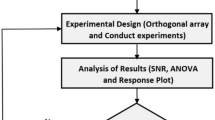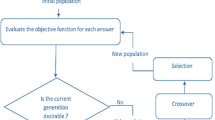Abstract
TiAl intermetallic alloy (Ti-45Al-2Mn-2Nb) is a typical hard-to-machine material which was used in the aero-engines. To study its machinability, the high-speed grinding experiments were conducted using electroplated diamond abrasive wheel. The effects of grinding parameters (e.g., grinding wheel speed vs, infeed speed vw, and grinding depth ap) on the grinding force and temperature were discussed. Then, the grey relational analysis (GRA) and variance analysis method were utilized to analyze the results. In addition, the evolution of the surface integrity was researched to characterize the machinability comprehensively. The results show that ap had the greatest effect on the normal grinding force and grinding temperature of TiAl intermetallics, while as for the tangential grinding force, vs did. When vs increases from 60 to 120 m/s, the residual stress along and perpendicular to the grinding direction decreased by 54.7% and 10%, respectively. The maximum microhardness of the ground surface increased to 620 HV0.05 at this moment, which was 1.55 times larger than that of the original matrix. Additionally, the chips morphology indicated that the adverseness of the low temperature plasticity of TiAl intermetallic alloy could be well overcome through the high-speed grinding tests. Finally, according to the GRA, the combination of vs=90 m/s, vw=0.5 m/min, and ap=0.1 mm was selected as the optimal parameter combination.









Similar content being viewed by others
Data availability
All data generated or analyzed during this study are included in the present article.
References
Klocke F, Herrig T, Zeis M, Klink A (2015) Experimental research on the electrochemical machinability of selected TiAl alloys for the manufacture of future aero engine components. Procedia CIRP 35:50–54
Kim YK, Hong JK, Lee KA (2020) Enhancing the creep resistance of electron beam melted gamma Ti–48Al–2Cr–2Nb alloy by using two-step heat treatment. Intermetallics 121:106771
Liang C, Li JS, Xue XY, Tang B, Kou HC, Perroud O, Bouzy E (2017) Effect of beta/B2 phase on cavitation behavior during superplastic deformation of TiAl alloys. J Alloys Compd 693:749–759
Chen ZZ, Wen DH, Lu JF, Yang J, Qi H (2021) Surface quality improvement by using a novel driving system design in single-side planetary abrasive lapping. Materials 14:1691
Qi H, Qin SK, Cheng ZC, Teng Q, Hong T, Xie Y (2021) Towards understanding performance enhancing mechanism of micro-holes on K9 glasses using ultrasonic vibration-assisted abrasive slurry jet. J Manuf Process 64:585–593
Bentley SA, Goh NP, Aspinwall DK (2001) Reciprocating surface grinding of a gamma titanium aluminide intermetallic alloy. J Mater Process Technol 118(1-3):22–28
Priarone PC, Rizzuti S, Rotella G, Settineri L (2012) Tool wear and surface quality in milling of a gamma-TiAl intermetallic. Int J Adv Manuf Technol 61(1-4):25–33
Li HN, Zhao S, Cao S, Chen H, Qi H, Sun X, Li C, Liu G (2021) Controllable generation of 3D textured abrasive tools via multiple-pass laser ablation: parameter effects and selection. J Mater Process Technol 295:117149
Li HN, Wang JP, Wu CQ, Zhao YJ, Xu J, Liu XL, Zhu WQ (2020) Damage behaviors of unidirectional CFRP in orthogonal cutting: a comparison between single- and multiple-pass strategies. Compos Part B 185:107774
Wang YG, Li CH, Zhang YB, Yang M, Li BK, Jia DH, Hou YL, Mao C (2016) Experimental evaluation of the lubrication properties of the wheel/workpiece interface in minimum quantity lubrication (MQL) grinding using different types of vegetable oils. J Clean Prod 127:487–449
Zhang YB, Li CH, Jia DZ, Li BK, Wang YG, Yang M, Hou YL, Zhang XW (2016) Experimental study on the effect of nanoparticle concentration on the lubricating property of nanofluids for MQL grinding of Ni-based alloy. J Mater Process Technol 232:100–115
Babu RP, Vamsi KV, Karthikeyan S (2018) On the formation and stability of precipitate phases in a near lamellar γ-TiAl based alloy during creep. Intermetallics 98:115–125
Shi Z, Malkin S (2006) Wear of electroplated CBN grinding wheels. J Manuf Sci Eng-Transact ASME 128(1):110–118
Ding WF, Barbara L, Zhu YJ, Li Z, Fu YC, Su HH, Xu JH (2017) Review on monolayer CBN superabrasive wheels for grinding metallic materials. Chin J Aeronaut 30(1):109–134
Masoumi H, Safavi SM, Salehi M (2014) Grinding force, specific energy and material removal mechanism in grinding of HVOF-sprayed WC–Co–Cr coating. Adv Manuf Process 29(3):321–330
Hwang TW, Evans CJ, Malkin S (2000) An investigation of high-speed grinding with electroplated diamond wheels. CIRP Annals-Manuf Technol 49(1):245–248
Choudhary A, Naskar A, Paul S (2018) Effect of minimum quantity lubrication on surface integrity in high-speed grinding of sintered alumina using single layer diamond grinding wheel. Ceram Int 4(14):17013–17021
Hood R, Cooper P, Aspinwall DK, Soo SL, Lee DS (2015) Creep feed grinding of TiAl using single layer electroplated diamond superabrasive wheels. CIRP J Manuf Sci Technol 11:36–44
Auste E, Niemannhr HR (1999) Machining of γ–TiAl. Adv Eng Mater 1(1):53–57
Xi XX, Ding WF, Wu ZX, Anggei L (2021) Performance evaluation of creep feed grinding of γ-TiAl intermetallics with electroplated diamond wheels. Chin J Aeronaut 34(6):100–109
Thepsonthi T, Özel T (2012) Multi-objective process optimization for micro-end milling of Ti-6Al-4V titanium alloy. Int J Adv Manuf Technol 63(9-12):903–914
Manimaran G, Kumar MP (2013) Multiresponse optimization of grinding AISI 316 stainless steel using grey relational analysis. Mater Manuf Process 28(4):418–423
Liu W, Deng ZH, Shang YY, Wan LL (2017) Effects of grinding parameters on surface quality in silicon nitride grinding. Ceram Int 43(1):1571–1577
Yao CF, Lin JN, Wu DX, Ren JX (2018) Surface integrity and fatigue behavior when turning γ-TiAl alloy with optimized PVD-coated carbide inserts. Chin J Aeronaut 31(4):826–836
Kothari K, Radhakrishnan R, Wereley NM, Sudarshan TS (2015) Microstructure and mechanical properties of consolidated gamma titanium aluminides. Powder Metall 50(1):21–27
Song MH, Kazuo F, Tatsuhiko T, Noda T (1999) High-resolution electron microscopy of γ-TiAl irradiated with 15 keV helium ions at room temperature. J Nucl Mater 271-272:200–204
Ghani JA, Choudhury IA, Hassan HH (2004) Application of Taguchi method in the optimization of end milling parameters. J Mater Process Technol 145(1):84–92
Chan JWK, Tong TKL (2007) Multi-criteria material selections and end-of-life product strategy: grey relational analysis approach. Mater Des 28(5):1539–1546
Pak SI, Oh TH (2010) The application of analysis of variance (ANOVA). J Vet Clinics 27(1):71–78
Durrande N, Ginsbourger D, Roustant O, Carraro L (2011) ANOVA kernels and RKHS of zero mean functions for model-based sensitivity analysis. J Multivar Anal 115(1):57–67
Sharman ARC, Aspinwall DK, Dewes RC, Clifton D, Bowen P (2001) The effects of machined workpiece surface integrity on the fatigue life of γ-titanium aluminide. Int J Mach Tool Manu 41(11):1681–1685
Murtagian GR, Hecker RL, Liang SY, Danyluk S (2010) Plastic deformation depth modeling on grinding of gamma titanium aluminides. Int Adv Manuf Technol 49(1-4):89–95
Fergani O, Shao Y, Lazoglu I, Liang SY (2014) Temperature effects on grinding residual stress. Procedia CIRP 14:2–6
Wang YD, Xu ZY, Hu JC, Zhang AN (2020) Surface integrity analysis of electrochemical machining of Y-TIAL alloys. Mater Today Commun 25:101686
Aspinwall DK, Dewes RC, Mantle AL (2005) The machining of Y-TIAL intermetallic alloys. CIRP Annals-manuf Technol 54(1):99–104
Nadolny K, Onek WK (2016) The effect of wear phenomena of grinding wheels with sol-gel alumina on chip formation during internal cylindrical plunge grinding of 100Cr6 steel. Int J Adv Manuf Technol 87(1):1–17
Hood R Lechner F, Aspinwall DK, Voice W (2007) Creep feed grinding of gamma titanium aluminide and burn resistant titanium alloys using Sic abrasive. Int J Mach Tool Manu 47(9):1486–1492
Pei-lum T (1995) An investigation of chip types in grinding. J Mater Process Technol 53(3 4):521–532
Funding
This work was financially supported by the National Natural Science Foundation of China (Nos. 51921003 and 51775275), National Key Laboratory of Science and Technology on Helicopter Transmission (Nanjing University of Aeronautics and Astronautics) (No. HTL-A-20G01), Major Special Projects of Aero-engine and Gas Turbine (No. 2017-VII-0002-0095), and the Foundation of Graduate Innovation Center in NUAA (No. KFJJ20200501).
Author information
Authors and Affiliations
Contributions
Tao Chen conceived the analysis and wrote the manuscript. Yejun Zhu collected the data and revised the manuscript. XinXin Xi and Haixiang Huan performed the experiment. Wenfeng Ding provided supervision on experimentation and manuscript preparation.
Corresponding author
Ethics declarations
Ethical approval
The article follows the guidelines of the Committee on Publication Ethics (COPE) and involves no studies on human or animal subjects.
Consent to participate
Not applicable.
Consent to publication
Not applicable.
Competing interests
The authors declare no competing interests.
Additional information
Publisher’s note
Springer Nature remains neutral with regard to jurisdictional claims in published maps and institutional affiliations.
Rights and permissions
About this article
Cite this article
Chen, T., Zhu, Y., Xi, X. et al. Process parameter optimization and surface integrity evolution in the high-speed grinding of TiAl intermetallics based on grey relational analysis method. Int J Adv Manuf Technol 117, 2895–2908 (2021). https://doi.org/10.1007/s00170-021-07882-x
Received:
Accepted:
Published:
Issue Date:
DOI: https://doi.org/10.1007/s00170-021-07882-x




